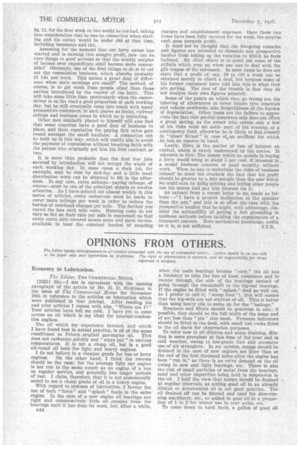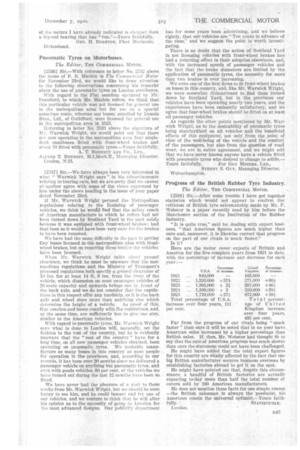OPINIONS FROM OTHERS.
Page 70

Page 71

If you've noticed an error in this article please click here to report it so we can fix it.
Economy in Lubrication.
The Editor, THE COMMERCIAL MOTOR.
[2535] Sir,—I am in agreement with the opening paragraph of the article by Mr. H. D. Nickinson in the issue of The Commercial Motor for November 16th in reference to the articles on lubrication which were published in that journal. After reading his and your articles I repeat with him, "Where am I?" Your articles have left me cold. I have yet to come across an oil which is my ideal for internal-combustion engines.
The oil which my experience favours, and which I have found best in actual practice, is oil of the same constituent as Price's original gas-engine oil. This does not carbonize quickly and "stays put" in various temperatures. It is not a cheap oil, but is a good all-round oil both for light and heavy engines.
I do not believe in a cheaper grade for bus or Lorry engines. On the other hand, I think the reverse should be the case; for the average light car engine is not run to the same extent as an engine of a bus on regular service, and generally has longer periods of rest. I claim, therefore, that it is not economically sound to use a cheap grade of oil in a heavy engine.
With regard to systems of lubrication, I favour the use of both "force" and "splash" feeds in the same engine. In the ease of a new engine all bearings are tight and comparatively little oil _escapes from the bearings until it has done its work, but, after a while, 544 when the main bearings become "easy," the oil has a tendency to take the line of least resistance and to escape through the side of the bearings instead of going through the crankshaft to the big-end bearings. If the engine be fitted with "splash" feed as well (or, as I prefer to call it, "scoop feed "), this will ensure that the big-ends are not starved of oil. This is better than using heavy oils to make up for the "leakage."
Strainers and filters should be generous in size; If possible, they should be the full width of the sump and of not less than " pin " size mesh. Pressure indicators should be fitted to the dash, with small test cocks fitted to the oil ducts for observation purposes.
To refer now to oil dilution and sump draining, dilution is more prevalent at this time of the year and in cold weather, owing to low-grade fuel and excessive use of air stranglers. In my opinion, sumps should be drained in the case of new engines not later than at the end of the first thousand miles after the engine has been "run in," as there is an extra demand on the oil owing to new and tight bearings, etc. There is also the risk of small particles of metal from the bearings, sand and other impurities being held in suspension in the oil. I hold the view that sumps should be drained at regular intervals, as adding good oil to an already diluted or deteriorated oil is not good practice. The oil drained off can be filtered and used for slow-running machinery. etc., or added to gear oil in a proportion of 1 to 3 for winter use in rear axles, etc.
To come down to hard facts, a gallon of good oil
of the nature I have already indicated is cheaper thau a big-end bearing that has" run."—Yours faitlifulIy, • GEO. IL Rusnroar, Fleet Mechanic. Birkenhead.
Pneumatic Tyres on Motorbuses.
The Editor, THE COMMERCIAL MOTOR.
125361 Sir,-With reference to letter No. 2532 above the name of F. R. Machin in The Cornmereiot Motor for November 23rd, we would like to draw attention to the following observations concerning his remarks about the use of pneumatic tyres on London omnibuses.
With regard to the Fiat omnibus operated by Mr.Dunsford, to which Mr. Machin refers, we think that this particular vehicle was not licensed for general use in the metropolitan area but for use on a special suburban route, whereas our buses, supplied by Dennis Bros., Ltd., of Guildford, were licensed for general use in the metropolitan area in 1925.
Referring to letter No. 2531 above the signature of lkir. Warwick Wright, we would point out that there are nevi operating in the metropolitan arca four singledeck omnibuses fitted with front-wheel brakes and about 70 fitted with pneumatic tyres.—Yours faithfully,
A. T. BENNETT AND CO., LTD..
ALFRED T. BEIft(F.TT, M.I.Mech.E., Managing Director. London, N.15.
125371 Sir,--We have always been very interested in .what " Warwick Wright says" in his advertisements
relating to touring cars, but we are sorry that we cannot eh-pa-ether agree with some of the views ex-pressed by him under the above heading in the issue of your paper dated November 23rd.
If Mr. Warwick Wright perused the Metropolitan regulations relating to the licensing of passenger vehicles, we think he would find that the safety coach
of American manufacture to which he refers had not been turned down by Scotland Yard in the past solely
because it was equipped with front-wheel brakes: had that been so it would have been very easy for the brakes to have been removed.
We have had the same difficulty in the past in getting Guy buses licensed in-the metropolitan area with frontwheel brakes, but on removing these brakes the vehicles have been licensed.
When Mr. Warwick Wright talks ;Mont ground clearance, we think he must be unaware that the met ropolitan regulations and the Ministry of Transport's proposed regulations both specify a ground clearance of 10 ins, for at least 14 ft. 6 Ins, from the front of the vehicle, which dimension on most nasslaiger vehicles of
26-seats capacity and upwards brings one in front of -the back axle, and we do not consider Ilint the regula
tions in this respect offer any hardship, as it is the back axle and wheel sizes more than anything else which determine the height of a vehicle. As proof of this.
Guy coaches and buses comply with the regulations, and, at the same time, are sufficiently low to give one step, similar to the American vehicles.
With regard to pneumatic tyres, Mr. Warwick Wright says what is done in London will, naturally, set the
fashion to the rest of the country, but he is evidently unaware that the "rest of the country" have for a long time, on all new passenger vehicles obtained, been operating on pnuetnatic Ayres. We probably manu
facture as many buses in this country as most people for operation in the provinces, and, according to our records, it has been over 20 months since we delivered a passenger vehicle on anything hut pneumatic tyres, and even with goods vehicles, 60 per cent. of the vehicles we have turned out during the last 12 months have been so fitted.
We have never had the pleasure of a visit to these works from Mr. Warwick Wright. but we should be most
happy to see him, and he could inspect and try one of our vehicles, and we venture to think that be will alter his opinion as to the necessity of going to America for the most advanced designs; Our publieify department
has for some years been advertising, and we believe rightly, that our vehicles are "Ten years in advance of the time," and we suggest the point is worth investigating.
There is no doubt that the action of Scotland Yard in not licensing vehicles with front-wheel brakes has had a retarding effect in their adoption elsewhere, and, with the increased speeds of passenger vehicles and the fact that the brake diameters are limited by the application of pneumatic tyres, the necessity for more than two brakes is ever increasing.
We were one of the first firms to fit front-wheel brakes on buses in this country, and, like Mr. Warwick Wright, we were somewhat disheartened to find them turned down by Scotland Yard, but in the provinces our vehicles have been operating nearly two years, and the experiences have been eminently satisfactory, and we agree that four-wheel brakes should be fitted on at least all passenger vehicles,
As regards the other points mentioned by Mr. Warwick Wright, as to the desirability of pneumatic tyres being standardized on all, vehicles and the beneficial effects of this equipment, not only from the point of view of the well-being of the vehicle and the comfort of the passengers, but also from the question of road wear, we are in entire agreement, and we might add that we have never known anyone have a vehicle fitted with pneumatic tyres who desired to change to solids.—
Yours faithfully, For GUT MOTORS, LTD., SYDNEY S. GITY, Managing Director. Wolverhampton.
Progress of the British Rubber Tyre Industry.
The Editor, THE COMMERCIAL MOTOR.
[2538] Sir,—After some trouble I have got together statistics which would not appear to confirm the criticism of British tyre salesmanship made by Mr. F. Webster in a paper recently read by him before the Manchester section of the Institution of the Rubber Industry.
"It is quite true," said he, dealing with export business, "that American figures are much higher than ours and, moreover, it is likewise correct that progress on the part of our rivals is much faster."
Is it?
Here are the motor cover exports of Britain and America for the five complete years from 1921 to date, with the percentage of increase and decrease for each year :— increase over four years,. ill per cent.
age of United Kingdom increase over four years, 435 per cent.
Far from the progress of our rivals being' "much faster" than ours it will be noted that in no year have American sales increased by a higher percentage than British sales. , If, then, Mr. Webster had thought fit to say that the rate of American progress was much slower, than ours the statement Could not have been challenged.
He might have added that the total export figures for this country are vitally affected by the fact that one big British manufacturer secures business overseas by establishing factories abroad to get it on the spot.
He might have pointed out that, despite this circumstance, a handful of British factories are actually exporting to-day more than half the total number of covers sold by 160 American manufacturers.
He does not mention these facta for one simple reason —the British salesman is always the pessimist, his American cousin the universal optimist.—Yours faith
fully, STATISTICIAN. LO-1(1011.




















































































































